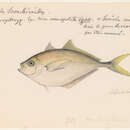Diagnostic Description
provided by Fishbase
Diagnosis: body compressed and deep (depth comprised from 2.3 to 2.8 times in fork length) (Ref. 57392), its ventral profile distinctly more convex than the dorsal (Ref. 26938, 57392). Snout very short, its tip blunt, upper jaw extending almost to behind level of anterior eye margin; 2 dorsal fins, the first with 8 spines, the second with 1 spine and 25-28 soft rays; anal fin with 2 detached spines, followed by 1 spine and 25-28 soft rays; upper lobe of caudal fin longer than the lower; small, cycloid scales covering most of body, including chest; 5-15 weak scutes on posterior part of lateral line, at level of caudal peduncle, the latter without bilateral keels (Ref. 57392). Metallic blue above, silvery below; caudal peduncle with black saddle spot (Ref. 3197).Coloration: back greenish or bluish, sides silvery-white; a dark, saddle-shaped blotch on caudal peduncle just before caudal fin, and another at upper angle of gill cover (Ref. 57392).
- Recorder
- Cristina V. Garilao
Morphology
provided by Fishbase
Dorsal spines (total): 9; Dorsal soft rays (total): 25 - 28; Analspines: 3; Analsoft rays: 25 - 28
- Recorder
- Cristina V. Garilao
Trophic Strategy
provided by Fishbase
Found over soft bottoms of the continental shelf; sometimes forming schools near the surface (Ref. 5217). Feeds on fish, cephalopods, zooplankton and detritus (Ref. 28587, 57616). Juveniles common in brackish estuaries (Ref. 5217) and often associated with jellyfish. Larvae feed primarily on cladoceran Penilia avirostris, copepods and nauplii, and the number and size of prey increased with larval development (Ref. 75983). These are the main food item components of the larval diet in spring and summer. Larval feeding incidence was higher during the day and it increases as the larvae grow (Ref. 75983).
Biology
provided by Fishbase
Adults are found over soft bottoms of the continental shelf; sometimes forming schools near the surface (Ref. 5217). Marine pelagic species very common in coastal lagoons and estuaries (Ref. 57392). They feed on fish, cephalopods, zooplankton and detritus (Ref. 28587). Juveniles common in brackish estuaries and often associated with jellyfish (Ref. 5217). Marketed fresh and salted.

